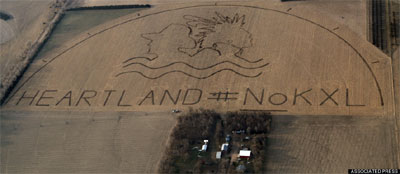This weekend, Willie Nelson and Neil Young played to a sold-out crowd of 8000 at Harvest the Hope: A Concert to Protect the Heartland … from tar sands oil.
Hosted at a farm along the proposed Keystone pipeline route in Nebraska, the crowd cheered when the two icons sang "This Land Is Your Land." The owners of the farm are one of 115 landowners who refused to sell their land to TransCanada – it’s the latest in the fight against the pipeline, this time to rally farmers and Native Americans.
This isn’t the first time Neil Young has spoken out against the pipeline. He called Alberta’s tar sands a "wasteland" that "looks like Hiroshima."
"America has a chance to stand up and lead the world like we used to. So we’re not just standing here complaining about problems, but finding solutions, Neil Young told Omaha World-Herald. His new song is "Stand Up and Fight."
Proceeds from the concert go to Bold Nebraska, Indigenous Peoples Network and Cowboy & Indian Alliance to fund the ongoing fight against Keystone, as well as clean energy projects on local farms and tribal lands.
Also at that farm is the world’s largest living crop art installation. The size of 80 football fields, it can be read from the air, "Heartland #No KXL."

Activists have held off the Keystone pipeline for six years, so far preventing 1,827,386,000 barrels of tar sands oil from being extracted from the ground and keeping over a billion metric tons of carbon from release into the atmosphere, according to Friends of the Earth’s counter.
In September, 500 people evacuated their homes, after yet another TransCanada pipeline rupture in Canada.
Three Companies Cancel Tar Sands Projects
While TransCanada loves to push the Keystone pipeline by saying the oil will get delivered one way or the other, that’s looking less likely.
Recently, three projects to expand tar sands mines have been shelved by Total E&P Canada, Shell and Statoil. They say rising costs and a lack of infrastructure to get the oil to market (Keystone pipeline) makes them uneconomic.
In addition to rising labor costs, "Market access issues also play a role – including limited pipeline access, which weighs on prices for Alberta oil, squeezing margins and making it difficult for sustainable financial returns," says Ståle Tungesvik, who manages the company in Canada.
"This is clear evidence that the growth of the tar sands industry is directly linked to the availability of pipelines like Keystone XL," says Danielle Droitsch of the Natural Resources Defense Council. "Total E&P is a confirmed Keystone XL shipper and the costs of transporting tar sands is an integral indicator to determine whether a tar sands operation is profitable given the industry is landlocked and critically dependent on transport to move its product to markets."
State Department Does It Again!
Indeed, this shows the fallacy of the State Department’s flawed environmental analyses under then-Secretary Hillary Clinton. A prime reason they concluded the Keystone pipeline would have minimal environmental impact is because Canadian tar sands will make it to market with or without it.
And they are doing their part to make it so.
Enbridge, responsible for the Kalamazoo River tar sands spill, has quietly gotten approval to double the tar sands oil it brings into the US through its Alberta Clipper pipeline.
It currently delivers 450,000 barrels of tar sands oil a day from Alberta to Wisconsin, after which it’s distributed through other pipelines to refineries in the Midwest and South. Now, Enbridge has found a sneaky way to more than double that – more than Keystone would carry – without any environmental analysis or public input.
In June, Enbridge announced that while it’s waiting on a State Department permit to increase the amount of oil, it would simply divert the oil through another pipeline that carries conventional crude – and which already has a permit.
Just above the US border, it’s transferring oil to Line 3. Once it crosses the border, it transfers back to Alberta Clipper. Since the move only affects "a few miles around the border," the State Department says it can move forward!
The 47-year-old Line 3 is not a tar sands pipeline and has not been approved as such.
Then, Enbridge got a hand from the Federal Energy Regulatory Commission (FERC), which gave them a permit to open a tar sands-by-rail facility in Illinois by early-2016. That’s located at yet another pipeline, Flanagan South, which goes to Oklahoma. From there, it meets Enbridge’s Seaway Twin pipeline for the final trip to the Gulf.
Enbridge now has the capacity to bring about 960,000 barrels a day to the Gulf! And it would also build the Northern Gateway pipeline, which was approved by Canada in June.
Of course, TransCanada is now also looking at rail. It costs twice as much to transport it that way, but it would be a bridge until Keystone gets built, they say. There could never be enough rail cars to carry that much oil and the amount already be transported is making difficult for farmers to get their crops to market.
Even more ironic, is that storage tanks are filled at the Gulf with all that oil – with nowhere to go because of US laws that prevent export.
Meanwhile, environmental organizations and scientists now want the State Department to evaluate the cumulative climate impacts of these pipelines as part of its Alberta Clipper environmental analysis. Under the National Environmental Policy Act (NEPA), cumulative impacts of proposed projects must be combined with past, present and reasonably foreseeable projects.
A "tyranny of incremental decisions" has already allowed tar sands production to double, and "impacts mount with multiple projects," say scientists.

Neil Young has “Lost His Mind …!”